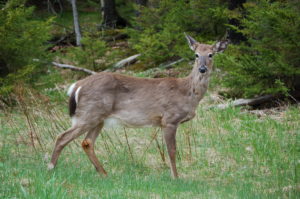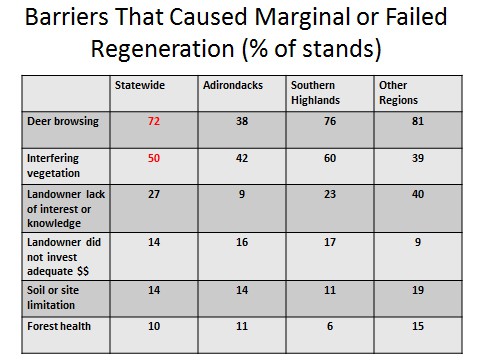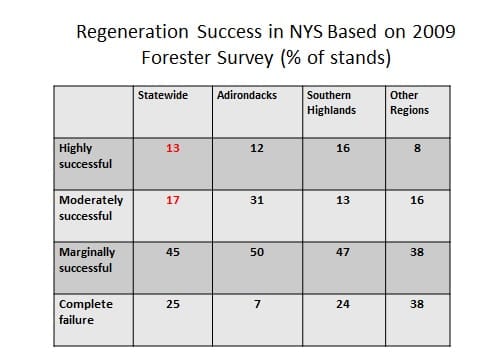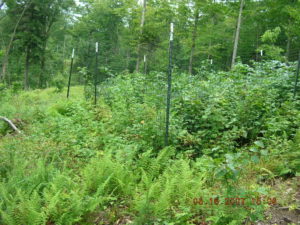Regenerating Your Next Forest: Keys to Success
by Paul Curtis, Gary Golf, and Jason Boulanger
Have you ever wondered what it takes to regenerate your forest? Do you think that all you have to do is let nature take its course, or plant some seedlings to help things along? Some New York forest owners have discovered that forest regeneration is not so simple.

White-tailed deer will selectively browse and remove preferred tree seedlings from the forest up to a height of 5 to 6 feet.
Understanding the barriers to forest regeneration enables owners and managers to adjust their management practices accordingly for a particular stand or site. Focusing attention on those barriers most limiting to seedling growth improves the likelihood of successful regeneration and contributes to the sustainability of woodlands in New York.
The key to successful tree regeneration depends on three critical components: 1) appropriate silvicultural applications, 2) removal of competing vegetation, and 3) protecting young seedlings from deer herbivory (browsing). Each of these management actions are interrelated, thus if any one of these components is ignored, the likelihood of successful hardwood regeneration is negatively affected.
Regeneration of valuable timber species requires favorable site and forest conditions in order to establish seedlings. Owners can expect very little regeneration until the canopy is opened enough to provide sufficient light on the forest floor to stimulate new plant growth. First, there must be either adequately dense numbers of desirable seedlings on the forest floor, ready to shoot up after the opening of the canopy, or there must be an adequate and timely source of seeds or nuts that will provide the source of new seedlings.
Some species will propagate from stump or root suckers, but generally these are subject to poor form and less desirable than seedlings. Various harvest regimes are designed to provide suitable conditions of light and seed source to “jump start” the process of regeneration. For example, using seed-tree or clear-cutting harvest regimes will provide favorable conditions for regeneration of species that require lots of light (e.g., aspen and cherry). Assessing current conditions and choosing the right manner by which to start the regeneration process is dependent on many variables such as soil conditions, stand history, dominant species in the canopy, desired tree species, the size of the area cut for regeneration, and likely impact of deer browsing. Selectively removing a few trees from a stand has a poor chance of creating suitable regeneration where deer populations are too high, as deer can quickly consume the species that they prefer. You should consult a professional forester for harvest recommendations to meet your management goals.

Barriers to regeneration in New York forests, 2008.
Even with sufficient light hitting the forest floor, problems can still occur. Often as a result of a too-abundant deer herd, in combination with relatively low light levels, an understory composed of deer-resistant plants such as American beech or hay-scented ferns, or exotic invasive species such as garlic mustard or European buckthorn, will dominate the understory. Opening the canopy (via a harvest or thinning) under such conditions will allow those species to flourish, creating beech or buckthorn thickets, and/or a mat of ferns at the ground level. Under these conditions, few tree seeds are able to survive through their germination and establishment phases. Those that do survive will grow slowly due to dense shade, and will thus be unable to attain the height of five or more feet needed to escape deer browsing. As you can see, successful regeneration of desirable tree species is dependent on devising a forest management plan that addresses a combination of interacting factors. Under such conditions various mechanical or herbicide treatments may be needed to control competing vegetation. This topic will be discussed further in upcoming articles in this series.
Once tree seedlings are established, an adequate number must then escape herbivory, especially from white-tailed deer. Herbivory is believed to be a severe limitation on regeneration for many woody plants because of high deer densities. For example, in much of southern New York, deer abundance exceeds 35 deer per square mile. With this level of foraging pressure from deer, preferred seedlings such as oaks, maple, and ash, have little chance for successful reestablishment. Species that deer generally avoid, such as American beech, black birch, hophornbeam, striped maple, and numerous invasive species may dominate the seedling layer in such forests. Foresters and wildlife biologists generally agree a deer density of fewer than 20 deer per square mile will allow for regeneration of desired trees if deer have alternative food sources, such as farm crops. However, where deer must live primarily on tree browse (such as in parts of the Catskill or Adirondack Mountains), deer densities of as low as 8 to 10 per square mile can result in complete regeneration failure.
The extent of deer impacts on forest regeneration in New York State was assessed in 2009. To obtain this information statewide, we conducted a mail survey to gather the expert opinions of foresters currently working in the state. The survey dealt with foresters’ general experiences with forest regeneration, barriers to successful regeneration, management activities they would recommend, and activities they thought landowners should implement.
Respondents indicated that they had examined almost 5,000 properties during 2008, during times when snow depth did not limit their ability to assess forest regeneration. This represents almost 17,000 stands and 700,000 acres examined.

Potential regeneration success of forest stands in 2008 based on expert opinion of New York foresters.
Foresters said that 31% of all the stands (and 30% of all the acreage) they evaluated in 2008 were ready to be regenerated. “Successful” regeneration was defined as desirable species that had a reached a height of at least 5 feet, and occupy the stand with an adequate number of stems per acre. About one-quarter (28%) of all the stands, and 27% of all the acreage that foresters inspected had a harvest in the last 10 years that was sufficiently intense to open the canopy for sunlight that could establish a new age class of trees. Unfortunately, the anticipated regeneration success of those stands, statewide, was largely unsuccessful. For stands where foresters could assess regeneration, statewide regeneration was moderately or highly successful only 30% of the time.
Barriers to regeneration success were linked primarily to deer and the growth of interfering vegetation. Foresters indicated that 72% of all the marginally-successful or completely-failed stands statewide were impacted by deer browsing. Half of all stands were also impacted by interfering vegetation. Once again, note that these barriers are interacting forces, and it is impossible to separate out their singular impact. Forest health or soil/site limitations seldom were considered barriers to tree regeneration.

Fenced exclosure to prevent deer foraging and evaluate the impacts of deer on forest regeneration. This exclosure has been in place for 3 years.
Where we have constructed small deer exclosures to evaluate the impacts of deer on vegetation, the results are often striking in just a few years. Ferns and other deer-resistant plants dominate vegetation outside fences. Inside the exclosures, plant diversity and height is much greater after as little as three years. Results have been similar in trials conducted in the Southern Tier and Adirondack forests. Even relatively low deer densities can have impacts in areas with poor soils or short growing seasons. Multiple barriers could impact forest regeneration, and if there are existing site limitations, abundant deer will only compound those problems.
Foresters often recommend a specific regime for timber harvest or stand improvement to encourage successful regeneration. The harvest regime is chosen in consideration of the likelihood of achieving ownership goals, given the barriers present. In areas outside the Adirondacks, most foresters also recommend antlerless deer harvest. Fencing to exclude deer is rarely recommended, presumably because the cost of fencing will not allow adequate return on the investment when the sawtimber is sold several decades later. However, small fenced deer exclosures can highlight the local impacts of deer on forest regeneration.
For Additional Information on Forest Regeneration
Connelly, NA, PJ Smallidge, GR Goff and PD Curtis. 2010. Foresters perception of forest regeneration and possible barriers to regeneration in New York State. Cornell University Department of Natural Resources Human Dimensions Research Unit HDRU 10-2. 37 pp.
Shirer, R and C Zimmerman. 2010. Forest regeneration in New York State. The Nature Conservancy. 25 pp.
Regenerating hardwood forests: Managing competing plants, deer and light. Penn State University, State College, PA. 7pp.
Jacobson, Michael. 2006. Forest finance 2: Fencing for forest regeneration: Does it pay? Penn State University, State College, PA. 5pp.
Given the impacts, the management of deer and competing vegetation limit the future sustainability of many forests across the state. If regeneration of stands is to be successful, many landowners must consider deer management. Hunting is the only management alternative that can address deer numbers and associated impacts at a landscape scale. Landowners should promote harvest of antlerless deer to attain lower densities several years prior to a harvest designed to start the regeneration process. Based on typical parcel sizes, it may be necessary to work with several neighbors to coordinate deer management efforts. Based on our experiences on university forest lands, it will take years of sustained hunting pressure and removal of adult does to lower deer densities sufficiently to achieve adequate seedling regeneration. This will be difficult to achieve for landowners in many parts of the state given the quality deer habitat and high deer densities currently on the landscape.
For more information on the impact of deer on forest regeneration, contact the authors: Paul Curtis at pdc1@cornell.edu, Gary Goff at grg3@cornell.edu, and Jay Boulanger at Boulanger@cornell.edu. Cornell University Cooperative Extension, Department of Natural Resources, Ithaca, NY.
This article originally appeared in the NY Forest Owner, Nov-Dec. 2012 issue. It is reprinted here with permission from the NY Forest Owners Association.


it’s a superb idea of regenerating the forest
Understanding the intricate balance between silvicultural practices vegetation management and deer browsing is crucial for successful forest regeneration. It is clear that addressing these interrelated factors is key to sustaining New York woodlands.
Solar Panel Installation in Oklahoma City